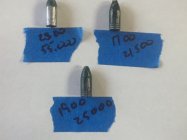That’s probably for subsonic.
@dellet could answer that for sure.
It’s a trick question, and the Blackout cartridge is probably the best test bed for this type of discussion, bullet weights from 80-265 grains, lengths from around .500” to 1.875”, twists from 1/4-1/12, anything from cast lead to lathe turned solids are readily available. Velocities range from 900-3000 fps.
With the Blackout, barrel length can be the single most important factor, if we eliminate subs. If we look at the difference between the fast twists say 1/5 and 1/6, it can mean the difference in about 16” of useful barrel.
An 8” 1/5 shooting a 110 grain Varmageddon can clock in around 2150 fps spinning around 310,000 rpm.
A 24” 1/6 you can push that same bullet to 2700 fps and spin at 325,000 rpm.
Rate of fire comes into play. At a slow pace firing, either one will shoot all day without a problem. Take the 8” to a carbine course, and you’re likely to find the the inside of your suppressor hollowed out in about 40 rounds because the bullets are coming apart at the muzzle.
There is a reason you won’t find a 1/5 twist barrel over about 8-9” shooting supers.
Some of the most popular expanding subs are a disaster in a 1/5. Sig was shopping for a few specific bullets for the 1/5, it was a narrow set of specs. The Lehigh 194 opened in flight as slow as 900 fps.
It’s real easy to figure that a bullet in a 1/5 is spinning twice as fast as a 1/10, three times a 1/15. How well will a custom 110-120 grain BR bullet hold up at 350,000+ rpm?
It doesn’t matter the cartridge, when you get into fast twists, you need to crunch the numbers and match the bullet construction to the desired spin rate and type of shooting. Blowing up bullets became kind of a hobby for a couple summers.
It really changed my thinking about Bullet choice most likely to be used, as the starting point choosing a twist. Shooting a 150 grain brass solid, that might be 1/2” longer than something like a 150 Gold dot that is basically a plated lead.
So “what is maximum twist” really is a deep rabbit hole.











